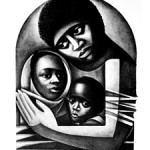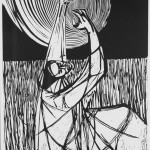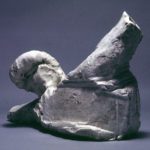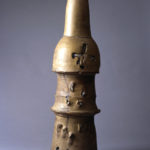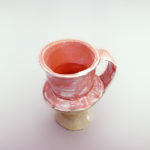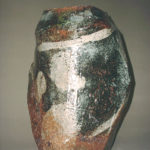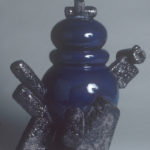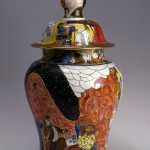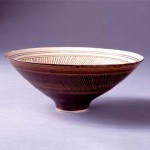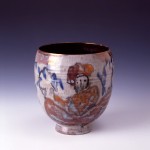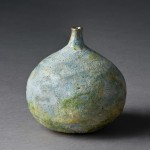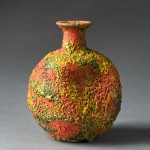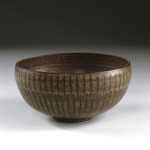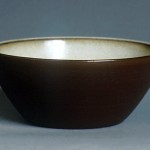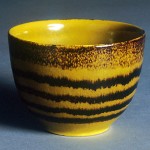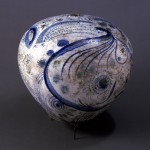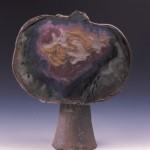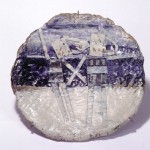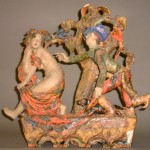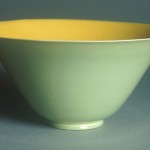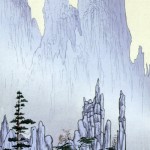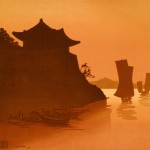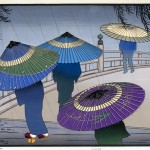Art from the Scripps College permanent collection has appeared in major exhibitions across the country, at venues such as the Museum of Fine Arts in Boston, The Metropolitan Museum of Art in New York, and the Pennsylvania Academy of Fine Arts, along with Southern Californian institutions such as LACMA, the UCLA Fowler, and the Pacific Asia Museum. First exhibited at Scripps in 2006, the Chikanobu exhibition of Japanese prints has completed its international tour and has returned to us after its final stop at the Morikami Museum in Florida.
NATURE/SUPERNATURE
Visions of this World and Beyond in Japanese Woodblock Prints
JAPAN HOUSE Los Angeles: February 15 – May 31, 2021
In the heart of Hollywood, this exhibition from the Scripps College collection introduces Japan’s most beautiful and beloved landscapes and the supernatural beings believed to inhabit them. NATURE/SUPERNATURE features over 60 woodblock prints by some of Japan’s finest artists: Katsushika Hokusai (1760-1849), Utagawa Hiroshige (1797-1858), Utagawa Kunisada (1786-1864), Utagawa Kuniyoshi (1797-1861), Tsukioka Yoshitoshi (1839-1892), Yōshū Chikanobu (1838-1912), Kawanabe Kyōsai (1831-1889), Yoshida Hiroshi (1876-1950) and Kawase Hasui (1883-1957). Curated by Meher McArthur, Art and Cultural Director at JHLA, these works encourage a deeper understanding of the Japanese natural environment and the ancient beliefs that continue to inform Japanese culture today.
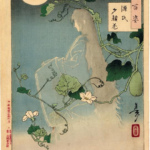
Tsukioka Yoshitoshi
One Hundred Aspects of the Moon: No. 29, Yugao, 1886
Ink on Paper
Gift of Mr. and Mrs. Marer
Scripps College, Claremont, CA
WTF Willumsen
Center for Kultur og Fritid Willumsens Museum: March 26 – October 31, 2021
The virtual exhibition WTF WILLUMSEN is curated by the young, Danish, feminist artist Stense-Andrea Lind-Valdan. The exhibition presents a number of artists gently, teasingly and sometimes more roughly challenging the highly performative, typically masculine (self-)representations of the major Danish artist J. F. Willumsen (1863-1958). In a bold, transhistorical curatorial approach Willumsen’s art is juxtaposed with works by artists such as Samella Lewis, Egon Schiele, Ana Mendieta, Meret Oppenheim, Frida Kahlo, Amoako Boafo, Kiki Smith, and Alfred Kubin among many others. The works speak of fragility, bodily experiences, vulnerability, loss, sorrow and empathy. The exhibition is built on the premises of the internet and offers “emergency exits” leading to external websites within a game structure, elegantly incorporating the intuitive impulse to jump from place to place, from image to image, within the digital.
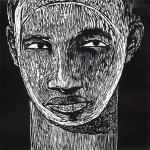
Samella Lewis
I See You, 2005
Ink on Paper
Jean and Arthur Ames Fund and the Hewett Mellon Presidential Discretionary Fund
Scripps College, Claremont, CA
Lasting Impressions: Selections from the Scripps College Permanent Collection
American Museum of Ceramic Art: January 12 – April 7, 2019
Curator: T Robert-Pacini
In the mid-1950s, renowned ceramist Paul Soldner came to Scripps after graduating from Otis and built the Scripps ceramic program into a major center of study. Soldner’s leadership of the Scripps program along with the Scripps Ceramic Annual, were the prime reasons ceramics collector Fred Marer decided to give his superb collection to the college. This exhibition of more than thirty objects from the Marer collection at Scripps College includes works from the Otis group and the creations of many others, including, Laura Andreson, Robert Arneson, Hans Coper, Phil Cornelius, Jun Kaneko, and James Melchert.
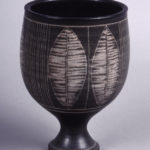
Harrison McIntosh
Compote, 1959
Stoneware
7 3/4 in. x 5 1/2 in. x 5 1/2 in
Scripps College, Claremont, CA
We Wanted a Revolution: Black Radical Women, 1965-85
Brooklyn Museum: April 21 through September 17, 2017
California African Museum, Los Angeles: October 13, 2017 through Jan. 14, 2018
Albright-Knox Art Gallery, Buffalo: February 17 through May 27, 2018
Institute of Contemporary Art, Boston: June 26 through September 30, 2018
Focusing on the work of black women artists, We Wanted a Revolution: Black Radical Women, 1965–85 examines the political, social, cultural, and aesthetic priorities of women of color during the emergence of second-wave feminism. It is the first exhibition to highlight the voices and experiences of women of color—distinct from the primarily white, middle-class mainstream feminist movement—in order to reorient conversations around race, feminism, political action, art production, and art history in this significant historical period.
-
Elizabeth Catlett
“Madonna”, 1982
Lithograph
Gift of Samella Lewis, Scripps College
- Samella Lewis, “Field” (Detail), 1968, Print, Jean and Arthur Ames Fund, Scripps College
Preserving China’s Past: Paintings of the Ming-Quing Dynasties
Carleton College, Perlman Teaching Museum: January 4 through February 19, 2017
Scripps College has a large collection of paintings from China dating to the Ming and Qing Dynasties (1368-1644 and 1644-1912). In recent years, over 30 paintings have been painstakingly conserved through grants from the E. Rhodes and Leona B. Carpenter Foundation, the National Endowment for the Arts, the Institute of Museum and Library Services, as well as the Jean and Arthur Ames Fund.
These conserved Chinese paintings will be on display at the Perlman Teaching Museum of Carleton College. Daoist paintings depict sages and immortals; Buddhist paintings feature monks and bodhisattvas; several images show butterflies, birds and flowers, or scholars and ladies in garden settings. Delicately detailed pictures of birds and flowers are contrasted to quickly brushed impressions of nature.
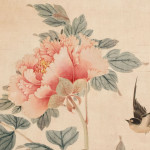
Signature of Jiang Tingxi, Peonies and Swallows (detail), 18th c., ink and colors on paper, 83.5 x 23.75 in., Munthe Collection, Scripps College
Voulkos: The Breakthrough Years
Museum of Arts and Design, New York City, New York: October 18, 2016 through March 15, 2017
Voulkos: The Breakthrough Years is the first exhibition to focus on the early career of Peter Voulkos, from 1953-1968. While trained as a traditional potter, Voulkos’ radical methods and ideas during this period opened up the possibilities for ceramics in ways that are still being felt today. Defying mid-century craft dictums of proper technique and form, Voulkos completely reinvented his medium. He combined wheel throwing with slab-building, traditional glazes with epoxy paint, figuration with abstraction, and made huge ceramic structures with complex internal engineering.
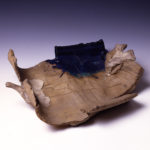
Peter Voulkos, Plate, 1963, Stoneware, glazed,
12 ¾ x 16 in. x 4 ¾, Gift of Mr. and Mrs. Fred Marer, Scripps College, Claremont, CA
Photo by Susan Einstein
Lineage: Mentorship and Learning
American Museum of Ceramic Art, Pomona, California: January 16 through June 19, 2016
This exhibition highlights the impact and importance of the teacher/student relationship. This exhibition illustrates the thread connecting multiple generations of ceramic artists from Peter Voulkos to today’s students.
- Jim Melchert, Container, 1960, stoneware and glazed, 13 in. x 20 in. x 6 in., gift of Mr. and Mrs. Fred Marer
- Peter Voulkos, Vase, 1975, Stoneware and glaze, 39 1/8 in. x 10 1/2 in. x 10 1/2 in., gift of Mr. and Mrs. Fred Marer
- Ken Price, Cup, 1960, White stoneware and low fire glaze, 4 in. x 3 1/2 in. x 3 in., gift of Mr. and Mrs. Fred Marer
- John Mason, Container, c. 1960, stoneware and glaze, 19 in. x 15 in. x 9 in., gift of Mr. and Mrs. Fred Marer
- Jerry Rothman, Ritual Vessel Series, c. 1980, porcelain and low fire glaze, 20 in. x 13 in. x 15 in.
Jewel City: Art from the Panama-Pacific International Exposition
Fine Arts Museums of San Francisco, San Francisco, California: October 17, 2015 through January 10, 2016
The year 2015 marked the centennial of the Panama-Pacific International Exposition (PPIE), the San Francisco world’s fair that celebrated the opening of the Panama Canal and the city’s reconstruction following the great earthquake of 1906. The grand exposition covered 76 city blocks and boasted national and international pavilions showcasing innovation, industry, and the arts. At the heart of the PPIE was one of the most ambitious art exhibitions ever presented in the United States, encompassing more than 11,000 paintings, sculptures, prints, and photographs, in addition to a significant array of public murals and monuments. To mark this anniversary, Jewel City revisited this vital moment in the inauguration of San Francisco as the West Coast’s cultural epicenter. The landmark exhibition at the de Young reassembled more than 200 works by major American and European artists, most of which were on display at this defining event.
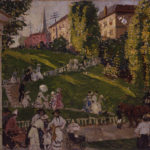
Gifford Beal, Old Town Terrace, 1914, oil on canvas, 36 1/4 in. x 48 1/2 in., gift of Millard Sheets, 1965
Crossroads in Clay at Chouinard and Otis: The Ralph Bacerra Years
Vincent Price Art Museum, East Los Angeles College, Monterey Park, California: September 19 through December 5, 2015
VPAM presented Crossroads in Clay at Chouinard and Otis: The Ralph Bacerra Years, a group exhibition featuring more than thirty former students of artist Ralph Bacerra (1938 – 2008). Bacerra is recognized as a revolutionary ceramic artist and pedagogue who worked during a pivotal wave of modern ceramic expression in Southern California. Although the common denominator of this exhibition is Bacerra, the show itself was not about him, but instead was a rarely-told narrative chronicling the post-Voulkos generation of ceramists who attended the institutions where Bacerra taught. Bacerra was a faculty member at the Chouinard Art Institute from 1963 to 1971, and headed the ceramics department at Otis College of Art and Design from 1983 to 1996.
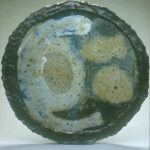
Jun Kaneko, Platter, 1965, glazed stoneware, 21 in. x 20 1/2 in. x 1 1/2 in., gift of Mr. and Mrs. Fred Marer
Tahoe: A Visual History
Nevada Museum of Art, Reno, Nevada: August 22, 2015 – January 10, 2016
The Nevada Museum of Art organized the first major art historical survey exhibition of painting, Native baskets, photography, architecture, and contemporary art dedicated to Lake Tahoe, Donner Pass, and the surrounding Sierra Nevada region. Tahoe: A Visual History spanned over two centuries of cultural and creative production related to the second deepest freshwater alpine lake in the United States. This historic show featured more than 400 artworks.
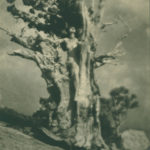
Anne Brigman, Invictus, 1925, gelatin silver print, 7 1/2 x 9 11/16 in, gift of C. Jane Hurley Wilson and Michael G. Wilson
Traditions Transfigured: The Noh Masks of Bidou Yamaguchi
California State University Long Beach, California: January 25 – April 13, 2014
The human face and its expressive potential have inspired artists around the world for millennia. Arguably, Japan’s Noh theater provides an unparalleled domain for exploring emotion and representing the human countenance. Today, Noh continues to inspire a dynamic dialogue between artists from Asia and the west. Expanding on this rich vein, Traditions Transfigured, both the exhibition, and its accompanying catalog, displayed contemporary works by Noh mask maker Bidou Yamaguchi. These masks applied the forms, techniques, transformative spirit, and mysterious elegance of Noh masks to iconic female portraits from the European art historical canon, and to Kabuki actor prints by Sharaku, Japan’s enigmatic 18th century portrait master. The exhibition employed a number of Japanese wood block prints from the Scripps collection.
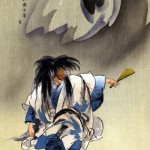
Tsukioka Kogyo: “100 Noh Plays: Nue”, 1922-25. Ink on paper. 15 x 10 1/8 inches. Purchase by the Aoki Endowment for Japanese Arts and Cultures.
Best Kept Secret: The Scripps College Ceramic Collection
American Museum of Ceramic Art, Pomona, California: January 11 – March 30, 2014
The American Museum of Ceramic Art (AMOCA) presented Best Kept Secret: The Scripps College Ceramic Collection, an exhibition organized by The Ruth Chandler Williamson Gallery at Scripps College. Curated by Kirk Delman, collections manager and registrar at Scripps, the exhibition featured work from the Scripps College Ceramic Collection. The show provided viewers with insights into the contributions of individual donors and an opportunity to assess the RCWG’s achievements as a collecting institution for more than six decades.
This exhibition of more than 180 objects included works from the Otis group and highlighted many others, including those of Laura Andreson, Robert Arneson, Hans Coper, Phil Cornelius, Shoji Hamada, Jun Kaneko, John Mason, and Jim Melchert.
Genji’s World in Japanese Woodblock Prints
Depauw University, Greensborough, Indiana: January 20 – April 21, 2013
Vassar College, Poughkeepsie, New York: September 20 – December 15, 2013
Morikami Museum and Japanese Gardens, Delray Beach, Florida: March 11, 2014 – May 18, 2014
The Tale of Genji, written over 1,000 years ago by the Japanese court lady Murasaki Shikibu, has greatly influenced Japanese culture, seen in paintings, prints, short stories, novels, noh plays, kabuki performances, operas, movies, symphonies, manga and anime. Featured in this exhibition was a rich array of woodblock prints by many of Japan’s leading artists, drawn from the Scripps College collection and the personal collection of Jack and Paulette Lantz. The exhibition was accompanied by an elaborately illustrated book, edited by Dr. Andreas Marks and published by Hotei Publishing. The exhibition was organized by Dr. Bruce Coats, Professor of Art History and Humanities.
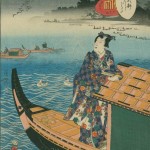
Utagawa Kunisada II, Murasaki Shikibu’s Genji Playing Cards: Ch. 39, Yugiri, 1857 (Detail); Ink on paper; 13 in. x 9 1/4 in.
Friendship Forged in Fire: British Ceramics in America
American Museum of Ceramic Art, Pomona, CA
February 9, 2013 – May 5, 2013
The historic “special relationship” between Great Britain and the United States spans decades and is deeply valued on both sides of the pond. Emerging from the alliances forged in the world wars over the first half of the 20th century, both British and American societies have benefited from the infusion of each other’s cultural contributions.
RCWG contributed works by Lucie Rie and Hans Coper to the exhibition.
Pacific Standard Time
At venues throughout Southern California, 2011-2012
The Ruth Chandler Williamson Gallery is proud to have been both an exhibition participant and a lending partner of the Getty’s Pacific Standard Time Initiative. Pacific Standard Time was a collaboration of more than 60 cultural institutions across Southern California, which came together for the first time to celebrate the birth of the L.A. art scene. The presenting sponsor was Bank of America.
In addition to Clay’s Tectonic Shift, the RCWG’s Pacific Standard Time exhibition, artwork from the Scripps permanent collection was seen in Pacific Standard Time exhibitions across the Southland.
Beatrice Wood: Career Woman–Drawings, Paintings, Vessels, and Objects
Santa Monica Museum of Art, Santa Monica, CA
September 10, 2011 – January 7, 2012
Beatrice Wood: Career Woman—Drawings, Paintings, Vessels, and Objects offered a comprehensive survey and a new assessment of this emblematic California artist—a scholarly, commemorative evaluation of Wood, whose extraordinary life and career traversed and contributed to the cultural and artistic highlights of the entire 20th century.
The exhibition included 100 of her works, from her early Dada work in painting and drawing to her later ceramic works. The RCWG contributed five of Beatrice Wood’s ceramic pieces, dating from 1955 to 1977.
Beatrice Wood was part of Pacific Standard Time.
- Beatrice Wood, Vase, 1955, Earthenware, 6½in. x 30½in. x 6½in., Gift of Mr. and Mrs. Fred Marer.
- Beatrice Wood, Vase, 1960, Stoneware, glazed, 3¾in. x 3 5/8in. x 3 5/8in., Gift of Donald and Bernice McKenna.
- Beatrice Wood, Vessel, 1972-73, Stoneware, glazed, 5½in. x 4in. x 4in., Gift of Donald and Bernice McKenna.
The House that Sam Built: Sam Maloof and Art in the Pomona Valley, 1945–1985
The Huntington Library, Art Collection, and Botanical Garden, San Marino, CA
September 24, 2011-January 30, 2012
Sam Maloof (1916–2009) was a woodworker born and raised in Southern California who became a nationally recognized leader of the American studio furniture movement—a movement that favored the aesthetics of craft and the handmade over the machine and mass-production. A major survey of his work, The House that Sam Built, showcased 30 important Maloof pieces spanning more than three decades of his career. These Maloof pieces were displayed with some 80 works by many of his friends and colleagues who worked in other media.
The House that Sam Built was part of Pacific Standard Time.
The RCWG lent 18 works by ceramicists Laura Andreson, Rupert Deese, William Manker, and Harrison McIntosh, enamellists Arthur and Jean Ames, and painter Henry Lee McFee.
- Laura Andreson, Bowl, 1954, Stoneware, glazed, 9 1/8in. x 9 1/8in. x 4¼in., Gift of Mr. and Mrs. Fred Marer.
- Rupert Deese, Sugar Bowl, 1956, Stoneware, 4½in. x 4½in. x 2in., Gift of Mr. and Mrs. Phil Dike.
- William Manker, Bowl, Porcelain, 4½in. x 4½in. x 3½in., Gift of Jean Ames’ Estate.
California Design, 1930-1965: Living in a Modern Way
Los Angeles County Museum of Art, Los Angeles, CA
October 2, 2011-January 22, 2012
This exhibition was the first major study of California midcentury modern design. With more than 300 objects—furniture, ceramics, metalwork, fashion and textiles, and industrial and graphic design—the exhibition examined the state’s role in shaping the material culture of the entire country. Organized into four thematic areas, the exhibition sought to elucidate the 1951 quote from émigré Greta Magnusson Grossman that is incorporated into the exhibition’s title: California design “is not a superimposed style, but an answer to present conditions… It has developed out of our own preferences for living in a modern way.”
California Design was part of Pacific Standard Time.
The RCWG contributed two slumped glass plates by Richard and Alice Petterson and a desk by Sam Maloof to the exhibition.
Crafting Modernism: Mid-Century American Art & Design
Museum of Art and Design, New York, NY
October 11, 2011 – January 15, 2012
National tour
Crafting Modernism was the fourth in a series of exhibitions on craft in the twentieth century. The show focused on the rich interplay of art and design in all craft media (clay, fiber, wood, metal, glass, and alternative materials) that exploded across the United States during the period from the 1940s to 1969. In the 1960s, artists increasingly began to consider the sculptural and aesthetic qualities of their materials, previously reserved for functional objects.
The RCWG lent Henry Takemoto’s First Kumu (1959) and Jerry Rothman’s Sky Pot (1960) to the exhibition.
- Henry Takemoto, “First Kumu”, 1959, Ceramic, glazed, 21¾in. x 22in. x 22in., Gift of Mr. and Mrs. Fred Marer.
- Jerry Rothman, “Sky Pot”, 1960, Stoneware, 8½in. x 25in. x 9in., Gift of Mr. and Mrs. Fred Marer.
Common Ground: Ceramics in Southern California 1945-1975
American Museum of Ceramic Art, Pomona, CA
November 12, 2011 – March 31, 2012
This seminal exhibition of mid-century Southern California pottery focused on the tremendous growth and experimentation in studio and industrial ceramic work during the decades following WWII. Artist Millard Sheets (1907-1989), a leading educator and designer, exerted considerable influence on a multitude of Los Angeles area art institutions. Sheets’ strongly held concept of “good design” acted as a catalyst in forming ceramic practices and opinions about art, interiors and architecture.
The RCWG contributed 24 ceramic works to the exhibition by various artists, including Albert H. King, Michael Frimkess, William Manker, John Mason, Jerry Rothman, Susi Singer, Henry Takemoto, and Beatrice Wood.
Common Ground is part of Pacific Standard Time.
- Michael Frimkess, “Platter”, 1960, Stoneware, glazed, 19in. x 19in. x 3in., Gift of Mr. and Mrs. Fred Marer.
- Susi Singer, “Aceton and Diana”, 1950, Earthenware, 16½in. x 19¼in. x 5in., Gift of the Fine Arts Foundation, Mr. Benjamin Kirby, and an Anonymous Donor.
- William Manker, Bowl, 1946, Earthenware, 6in. x 12¾in. x 12¾in., Scripps College, Claremont, CA.
Visions of the Orient: Western Women Artists in Asia, 1900-1940
Pacific Asia Museum, Pasadena, CA
March 3–May 29, 2011
National Tour
Visions of the Orient, one of the featured exhibitions in celebration of PAM’s 40th anniversary, focused on the work of four Western women artists: Helen Hyde (1868-1919), Bertha Lum (1869-1954), Elizabeth Keith (1887-1956), and Lilian Miller (1895-1942), all of whom trained initially as painters but, while living in Japan, also designed woodblock prints. The exhibition explored the intersection of Euro-American art, the woodblock print movement, women, and East Asia to view the various ways that “the orient” served as a liberating professional space for women artists and as a place of diverse creative inspiration.
The RCWG lent more than 20 prints by Lilian Miller, including some of the artist’s tools and pigments. Visions of the Orient is on a national tour this year, including stops at the National Museum of Women in the Arts in Washington DC, and the Jordan Schnitzer Museum of Art at the University of Oregon.
For more information, please click here.
- Lilian Miller, “Cathedral Cliffs”, 1928, Ink on paper, 14¼ x 9½in., Gift of Mrs. Simon Bolivar Buckner.
- Lilian Miller, “Korean Junks at Sunset”, 1928, Ink on paper, 14¼ x 14 7/8in., Gift of Mrs. Simon Bolivar Buckner.
- Lilian Miller, “Rain Blossoms”, 1928, Ink on paper, 9¾ x 14 5/8in., Gift of Mrs. Simon Bolivar Buckner.


